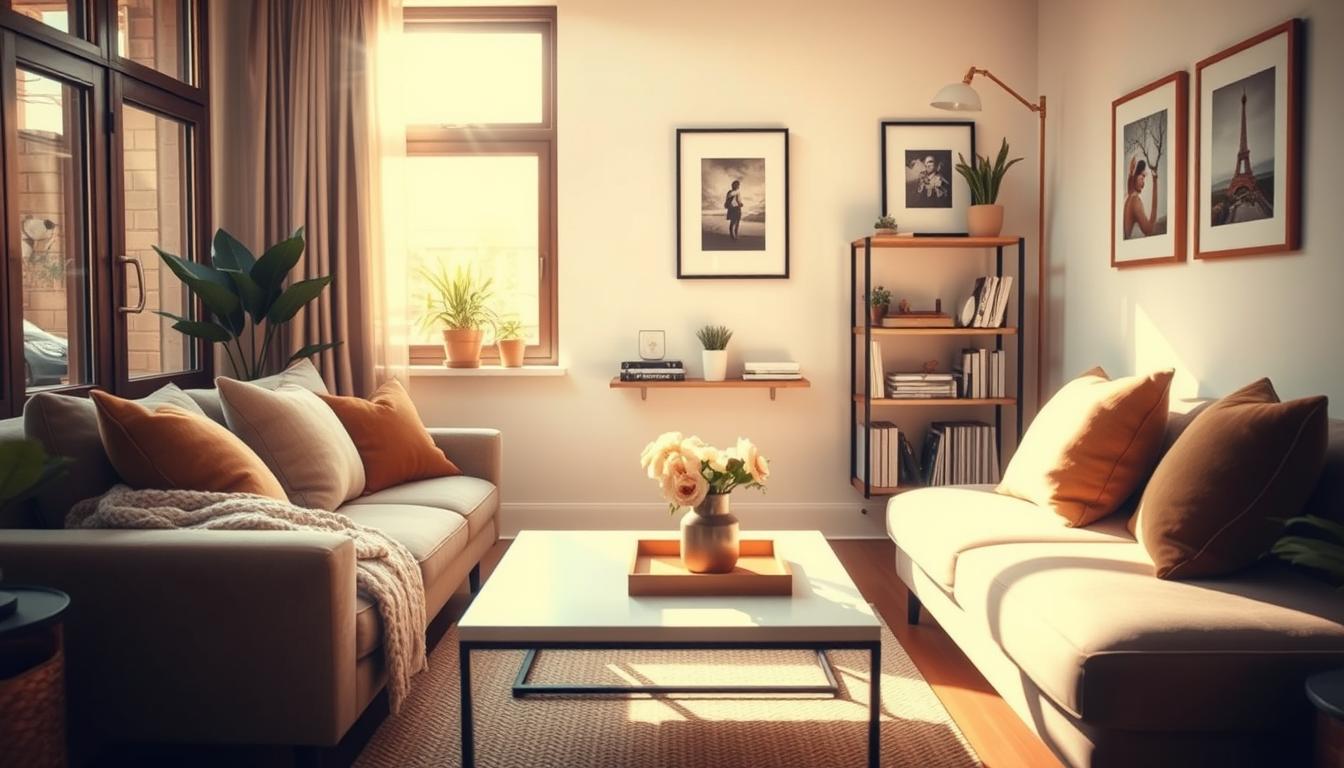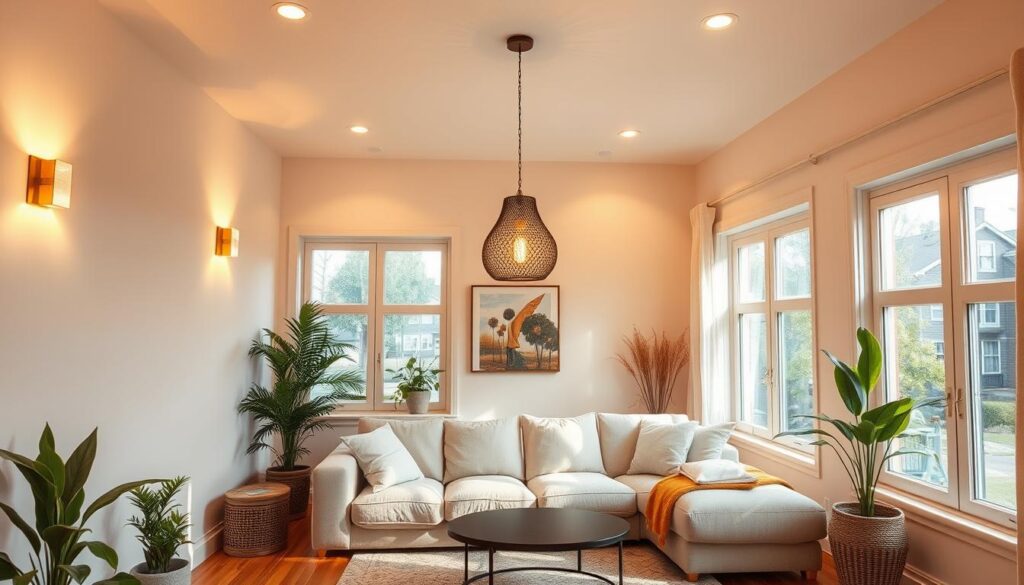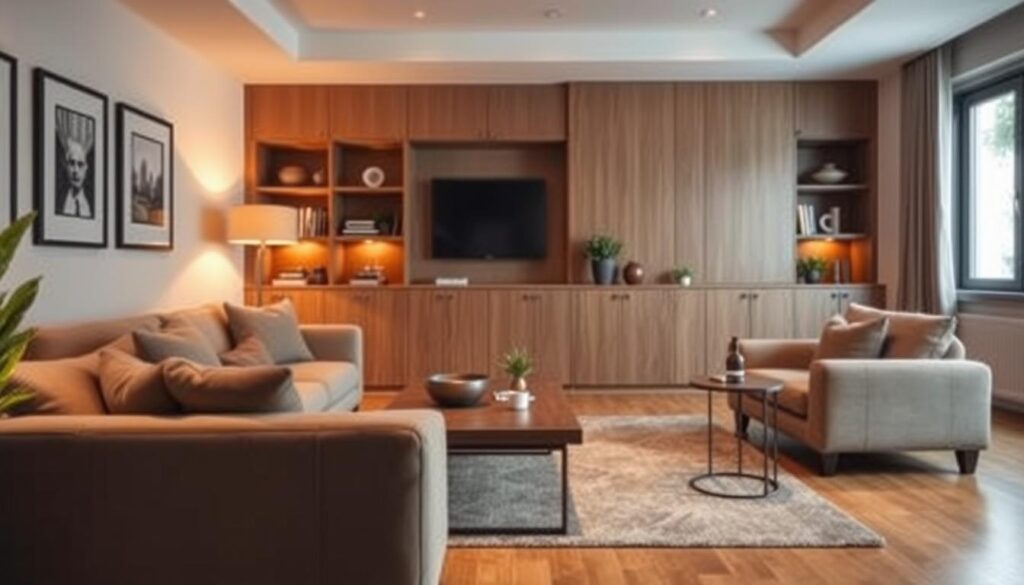
As I sat on my cramped sofa, I felt the walls closing in. I knew I had to make my small living room comfortable and joyful. Living in a small apartment, every inch was precious. I wanted to decorate it in a way that showed who I am and was functional.
Decorating a small space is more than just fitting furniture. It’s about creating a space filled with memories, experiences, and beauty. This journey taught me to turn my small space into a cozy and stylish home.
In this article, I’ll share small living room decor ideas. These ideas will make your space inviting and stylish. I’ll guide you through decorating your space, providing tips and inspiration. Together, we’ll make your small living room beautiful and welcoming.
Key Takeaways
- Maximize function without sacrificing style.
- Light colors can enhance the feeling of space.
- Multi-functional furniture is key to practicality.
- Vertical space should be utilized for decoration and storage.
- Personal touches make a small space uniquely yours.
Understanding the Challenges of a Small Living Room
Small living rooms come with their own set of challenges. These challenges can spark creativity or limit our options. Many believe that small spaces can’t be elegant or functional. But, understanding these beliefs opens the door to new solutions and design improvements.
Common misconceptions about small spaces
One common myth is that small rooms mean giving up style for efficiency. People think small spaces limit personal style and modern design. But, these limitations actually push us to make thoughtful choices.
By carefully choosing our decor, we can make a space that’s both stylish and personal. Embracing the challenges of small living rooms can lead to unique designs that showcase our creativity.
Benefits of decorating small rooms
Decorating small rooms has many benefits. For one, they encourage minimalism, which means less clutter and a more unified look. This simplicity makes the space more appealing without sacrificing comfort.
The cozy feel of a small living room creates a warm atmosphere perfect for personal connections. This can’t be matched in bigger rooms. By seeing the opportunities in small spaces, we can turn them into functional and enjoyable areas.
Choosing the Right Color Palette
The colors I pick for small living rooms really matter. They can change how the space feels and looks. Light colors like whites and soft ivories make rooms feel bigger. But, darker colors create a cozy and welcoming vibe.
To find the right mix, adding accent walls is key. They draw attention and add depth without making the room feel too busy.
Light colors versus dark colors
For small spaces, light colors like Benjamin Moore’s whites and grays work well. They make rooms feel airy and open. On the other hand, dark colors like navy blue or forest green create a cozy feel.
Using both light and dark colors can make a small room look better. It’s all about finding the right balance.
Accent walls to create depth
Accent walls can totally change a small space. They let you show off bold colors or patterns without taking over. Choosing colors that contrast well with the rest of the room adds depth.
For more ideas, check out great color palettes for small spaces. With the right colors and how you use them, a small room can look layered and interesting.
Selecting Furniture that Fits
Choosing the right furniture is key for a small living room. Opting for multi-functional pieces can make your space both useful and stylish. These items can do more than one thing, helping you use every inch of your room.
Multi-functional furniture options
Multi-functional furniture is great for small rooms. A sofa bed is perfect for sitting by day and sleeping by night. An ottoman with storage adds seating and keeps things tidy.
Coffee tables that can be raised for dining or nesting tables that fold away are also smart choices. Each piece helps make your room more versatile.
The importance of scale in furniture
Furniture scale is vital in a small room. Big pieces can make it feel tight and hard to move. Choose smaller items that fit well and keep the room flowing.
When you pick the right pieces, they can make the room look bigger. Mixing different sizes and shapes keeps things interesting. Remember, the right sizes create a balanced and cozy space.
| Furniture Type | Functionality | Best Uses |
|---|---|---|
| Sofa Bed | Seating and sleeping | Guest accommodations |
| Storage Ottoman | Seating and concealed storage | Living room accessories organization |
| Nesting Tables | Adds surface area | Flexible arrangements |
| Foldable Desks | Workspace and storage | Home office needs |
Utilizing Vertical Space Effectively
Maximizing vertical space can change how small living rooms look and work. By using smart strategies, I make my room more organized and pretty. The right ideas for vertical space can make the room look better and offer storage.
Shelving is key for small living rooms. It helps make the room look good and keeps things tidy.
Shelving solutions for small rooms
Putting shelves high on walls saves floor space. Floating shelves are great because they look good on walls and hold lots of things. They can hold books, plants, or decorations.
Using shelves of different heights makes the room look interesting. It makes the room look better and keeps things organized. Shelves are also a way to show off your style.
Hanging decor to draw the eye up
Hanging decor makes small living rooms more lively. Things like artwork, mirrors, or LED lights can make the room seem taller. Using different shapes and sizes makes the room look better and keeps it looking good.
This makes the walls more interesting and makes the room feel bigger. It makes the space feel more open and welcoming.
The Power of Mirrors in Design
Mirrors can change a small living room’s feel. They reflect light and make the space seem bigger. I place mirrors opposite windows or lights to brighten the room and add depth.
Using mirrors in small spaces makes decorating easy. It also makes the room feel bigger.
How mirrors can create illusions of space
Mirrors are key in making small areas look bigger. Their reflective surfaces add depth and make the room feel more open. Light bouncing off mirrors also brightens the room, removing shadows.
I choose mirrors to make my space feel open. They mix function with beauty.
Types of mirrors that work well in small rooms
Choosing the right mirror can change a room’s look. Here are some good options:
- Framed mirrors: They add style with a classic look.
- Floor-length mirrors: They make the room feel taller.
- Decorative wall mirrors: Unique shapes and designs are eye-catching and space-saving.
Adding these mirrors to my decor improves the room’s look. It also makes my small living room feel welcoming.
Lighting Strategies for a Cozy Atmosphere
Lighting is key to making a small living room welcoming. Using layered lighting, I can mix ambiance, function, and style. This means combining ambient, task, and accent lighting for a better look and feel.
Layered lighting techniques
Layered lighting is essential for comfort in small spaces. Ambient lighting sets the mood, while task lighting focuses on specific areas. Accent lighting brings out special features or artwork.
I also suggest placing lights in corners to reduce shadows. This is vital for small living rooms.
Choosing the right light fixtures
When picking light fixtures, I look for scale and style. Pendant lights, wall sconces, and recessed lighting are great for both looks and function. Chandeliers can be stunning even in small rooms, pulling the eye up.
Dimmer switches let me change the light’s intensity. This makes the room feel cozy for any time. For more ideas, check out this link.
| Lighting Type | Purpose | Best Fixtures |
|---|---|---|
| Ambient | General illumination | Ceiling-mounted fixtures, floor lamps |
| Task | Focused lighting for activities | Table lamps, reading lights |
| Accent | Highlight architectural features | Wall sconces, picture lights |
By using these strategies, I can make a room that’s both bright and cozy. Each lighting piece adds to the room’s look and makes it versatile for any mood or activity.

Incorporating Textiles for Warmth
Textiles can make a small living room warm and inviting. They add comfort and style, making the space feel cozy. By choosing the right area rugs, throw pillows, and blankets, I can turn my living room into a snug retreat.
Area rugs to define spaces
Area rugs do more than just cover the floor. They help define areas and guide the eye. A rug that matches the room’s colors can greatly improve its look. A well-chosen rug can also make the room feel bigger and more organized.
Throw pillows and blankets for comfort
Throw pillows and blankets bring comfort to any small living room. I like to mix different textures and patterns for interest. These soft items make the room feel welcoming, perfect for relaxing. Whether it’s velvet or knit, the right mix lets me change my decor with the seasons.
Personalizing Your Decor
Choosing the right art can change a small living room’s feel. Art that speaks to me turns a simple room into a reflection of my personality. Pieces from local artists or special photos give my space a story.
Selecting art that resonates with you
Art choice is more than looks; it’s about connection. Each piece should tell a part of my story or share my interests. Local landscapes or abstracts that echo my experiences warm up my decor.
This way, I gather a collection that’s both beautiful and meaningful.
Using personal photographs and mementos
Adding photos and mementos makes a small living room truly yours. Family photos, travel keepsakes, or gifts from friends create a personal gallery. This decor idea adds character and brings back memories.
Creating a Functional Layout
To make a living room work well, you need to think about furniture arrangement. It’s important to keep paths clear and furniture from blocking the way. This makes it easy to move around and sit comfortably.
Arranging furniture for flow
Where you put furniture really matters. Start with big pieces like sofas or entertainment units. They help set the layout. Adjusting the seating so people can talk face-to-face is key. And, placing furniture away from walls makes the room feel more open and welcoming.
Zoning spaces for different activities
Using space zoning makes a small living area more useful. I set up different areas for things like reading, chatting, or working. This way, the room is organized and each area has its own purpose. For example, a small table can mark a coffee spot, and a cozy chair can be for reading.

Adding Greenery to Your Space
Adding indoor plants to my small living room changes the vibe and brings in a fresh touch of nature. These plants clean the air and help lower stress. Even with little sunlight, there are plants that do well, making my space green without harming the plants.
Benefits of indoor plants
Indoor plants make a small living room lively and full of life. They can:
- Improve air quality by removing pollutants.
- Make the space calm and peaceful.
- Act as natural decor, softening the look of the room.
Best plants for low-light rooms
For plants that grow well in little light, I suggest these:
- Snake Plant: It’s tough and does well in indirect light.
- Pothos: It’s easy to care for and has beautiful vines.
- Peace Lily: It has stunning white flowers and does well in dim light.
Clever Storage Solutions
Creating an organized small living room often requires innovative solutions. Integrating clever storage for small rooms is key. By using hidden storage and maximizing under-furniture space, every inch is utilized.
Hidden storage ideas
Hidden storage can turn furniture into multifunctional pieces. Ottomans with internal compartments or coffee tables with drawers are great examples. They keep items out of sight while adding to the room’s look.
Utilizing under-furniture space
Maximizing under-furniture storage is a smart move. Decorative bins or attractive boxes keep essential items handy yet hidden. This approach declutters the space and improves the room’s appearance.
Final Touches for a Cohesive Look
The last step in decorating a small living room is adding finishing touches. These touches improve both function and style. I pick decor accessories like vases, candles, or books carefully. They should match the room’s color scheme or theme for a polished look.
Choosing the right accessories
Choosing the right accessories is key to decor harmony. I mix items of different heights and textures. This adds depth without making the room feel cluttered. It makes my small living room welcoming and shows off my style.
Balancing decor elements for harmony
Harmonizing decor is easy with a few decorative items on a shelf or table. I prefer groupings of three or five items. This creates interest and keeps things organized. These touches make the design cohesive, creating a space that truly feels like home.
